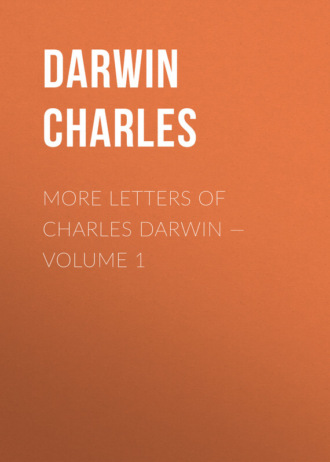 полная версия
полная версияMore Letters of Charles Darwin — Volume 1
I have always been willing to strike my colours on former immense tracts of land in oceans, if any case required it in an eminent degree. Perhaps yours may be a case, but at present I greatly prefer land in the Antarctic regions, where now there is only ice and snow, but which before the Glacial period might well have been clothed by vegetation. You have thus to invent far less land, and that more central; and aid is got by floating ice for transporting seed.
I hope I shall not weary you by scribbling my notions at this length. After writing last to you I began to think that the Malay Land might have existed through part of the Glacial epoch. Why I at first doubted was from the difference of existing mammals in different islands; but many are very close, and some identical in the islands, and I am constantly deceiving myself from thinking of the little change which the shells and plants, whilst all co-existing in their own northern hemisphere, have undergone since the Glacial epoch; but I am convinced that this is most false reasoning, for the relations of organism to new organisms, when thrown together, are by far the most important.
When you speak of plants having undergone more change since old geological periods than animals, are you not rather comparing plants with higher animals? Think how little some, indeed many, mollusca have changed. Remember Silurian Nautilus, Lingula and other Brachiopods, and Nucula, and amongst Echinoderms, the Silurian Asterias, etc.
What you say about lowness of brackish-water plants interests me. I remember that they are apt to be social (i.e. many individuals in comparison to specific forms), and I should be tempted to look at this as a case of a very small area, and consequently of very few individuals in comparison with those on the land or in pure fresh-water; and hence less development (odious word!) than on land or fresh-water. But here comes in your two-edged sword! I should like much to see any paper on plants of brackish water or on the edge of the sea; but I suppose such has never been published.
Thanks about Nelumbium, for I think this was the very plant which from the size of seed astonished me, and which A. De Candolle adduced as a marvellous case of almost impossible transport. I now find to my surprise that herons do feed sometimes on {illegible} fruit; and grebes on seeds of Compositae.
Many thanks for offer of help about a grant for the Abstract; but I should hope it would sell enough to pay expenses.
I am reading your letter and scribbling as I go on.
Your oak and chestnut case seems very curious; is it not the more so as beeches have gone to, or come from the south? But I vehemently protest against you or any one making such cases especial marvels, without you are prepared to say why each species in any flora is twice or thrice, etc., rarer than each other species which grows in the same soil. The more I think, the more evident is it to me how utterly ignorant we are of the thousand contingencies on which range, frequency, and extinction of each species depend.
I have sometimes thought, from Edentata (70/5. No doubt a slip of the pen for Monotremata.) and Marsupialia, that Australia retains a remnant of the former and ancient state of the fauna of the world, and I suppose that you are coming to some such conclusion for plants; but is not the relation between the Cape and Australia too special for such views? I infer from your writings that the relation is too special between Fuegia and Australia to allow us to look at the resemblances in certain plants as the relics of mundane resemblances. On the other hand, {have} not the Sandwich Islands in the Northern Hemisphere some odd relations to Australia? When we are dead and gone what a noble subject will be Geographical Distribution!
You may say what you like, but you will never convince me that I do not owe you ten times as much as you can owe me. Farewell, my dear Hooker. I am sorry to hear that you are both unwell with influenza. Do not bother yourself in answering anything in this, except your general impression on the battle between N. and S.
CHAPTER 1.III. — EVOLUTION, 1859-1863
LETTER 71. TO A.R. WALLACE. Down, April 6th, 1859.
I this morning received your pleasant and friendly note of November 30th. The first part of my MS. is in Murray's hands to see if he likes to publish it. There is no preface, but a short introduction, which must be read by every one who reads my book. The second paragraph in the introduction (71/1. "Origin of Species," Edition I., 1859, pages 1 and 2.) I have had copied verbatim from my foul copy, and you will, I hope, think that I have fairly noticed your paper in the "Linn. Journal." (71/2. "On the Tendency of Species to form Varieties, and on the Perpetuation of Varieties and Species by Natural Means of Selection." By Charles Darwin and Alfred Russell Wallace. Communicated by Sir Charles Lyell and J.D. Hooker. "Journ. Linn. Soc." Volume III., page 45, 1859. (Read July 1st, 1858.)) You must remember that I am now publishing only an abstract, and I give no references. I shall, of course, allude to your paper on distribution (71/3. "On the Law which has regulated the Introduction of New Species" (A.R. Wallace). "Ann. Mag. Nat. Hist." Volume XVI., page 184, 1855. The law alluded to is thus stated by Wallace: "Every species has come into existence coincident both in space and time with a pre-existing closely allied species" (loc. cit., page 186).); and I have added that I know from correspondence that your explanation of your law is the same as that which I offer. You are right, that I came to the conclusion that selection was the principle of change from the study of domesticated productions; and then, reading Malthus, I saw at once how to apply this principle. Geographical distribution and geological relations of extinct to recent inhabitants of South America first led me to the subject: especially the case of the Galapagos Islands. I hope to go to press in the early part of next month. It will be a small volume of about five hundred pages or so. I will of course send you a copy. I forget whether I told you that Hooker, who is our best British botanist and perhaps the best in the world, is a full convert, and is now going immediately to publish his confession of faith; and I expect daily to see proof-sheets. (71/4. "The Flora of Australia, etc., an Introductory Essay to the Flora of Tasmania." London 1859.) Huxley is changed, and believes in mutation of species: whether a convert to us, I do not quite know. We shall live to see all the younger men converts. My neighbour and an excellent naturalist, J. Lubbock, is an enthusiastic convert. I see that you are doing great work in the Archipelago; and most heartily do I sympathise with you. For God's sake take care of your health. There have been few such noble labourers in the cause of Natural Science as you are.
P.S. You cannot tell how I admire your spirit, in the manner in which you have taken all that was done about publishing all our papers. I had actually written a letter to you, stating that I would not publish anything before you had published. I had not sent that letter to the post when I received one from Lyell and Hooker, urging me to send some MS. to them, and allow them to act as they thought fair and honestly to both of us; and I did so.
(71/5. The following is the passage from the Introduction to the "Origin of Species," referred to in the first paragraph of the above letter.)
"My work is now nearly finished; but as it will take me two or three years more to complete it, and as my health is far from strong, I have been urged to publish this Abstract. I have more especially been induced to do this, as Mr. Wallace, who is now studying the Natural History of the Malay Archipelago, has arrived at almost exactly the same general conclusions that I have on the origin of species. Last year he sent to me a memoir on this subject, with a request that I would forward it to Sir Charles Lyell, who sent it to the Linnean Society, and it is published in the third volume of the Journal of that Society. Sir C. Lyell and Dr. Hooker, who both knew of my work — the latter having read my sketch of 1844 — honoured me by thinking it advisable to publish, with Mr. Wallace's excellent memoir, some brief extracts from my manuscripts."
LETTER 72. TO J.D. HOOKER. Down, May 3rd, 1859.
With respect to reversion, I have been raking up vague recollections of vague facts; and the impression on my mind is rather more in favour of reversion than it was when you were here.
In my abstract (72/1. "The Origin of Species.") I give only a paragraph on the general case of reversion, though I enter in detail on some cases of reversion of a special character. I have not as yet put all my facts on this subject in mass, so can come to no definite conclusion. But as single characters may revert, I must say that I see no improbability in several reverting. As I do not believe any well-founded experiments or facts are known, each must form his opinion from vague generalities. I think you confound two rather distinct considerations; a variation arises from any cause, and reversion is not opposed to this, but solely to its inheritance. Not but what I believe what we must call perhaps a dozen distinct laws are all struggling against each other in every variation which ever arises. To give my impression, if I were forced to bet whether or not, after a hundred generations of growth in a poor sandy soil, a cauliflower and red cabbage would or would not revert to the same form, I must say I would rather stake my money that they would. But in such a case the conditions of life are changed (and here comes the question of direct influence of condition), and there is to be no selection, the comparatively sudden effect of man's selection are left to the free play of reversion.
In short, I dare not come to any conclusion without comparing all facts which I have collected, and I do not think there are many.
Please do not say to any one that I thought my book on species would be fairly popular and have a fairly remunerative sale (which was the height of my ambition), for if it prove a dead failure it would make me the more ridiculous.
LETTER 73. TO W.H. MILLER. Down, June 5th {1859}.
I thank you much for your letter. Had I seen the interest of my remark I would have made many more measurements, though I did make several. I stated the facts merely to give the general reader an idea of the thickness of the walls. (73/1. The walls of bees' cells: see Letter 173.)
Especially if I had seen that the fact had any general bearing, I should have stated that as far as I could measure, the walls are by no means perfectly of the same thickness. Also I should have stated that the chief difference is when the thickness of walls of the upper part of the hexagon and of the pyramidal basal plates are contrasted. Will you oblige me by looking with a strong lens at the bit of comb, brushing off with a knife the upper thickened edges, and then compare, by eye alone, the thickness of the walls there with the thickness of the basal plates, as seen in any cross section. I should very much like to hear whether, even in this way, the difference is not perceptible. It is generally thus perceptible by comparing the thickness of the walls of the hexagon (if not taken very close to the angle) near to the basal plates, where the comparison by eye is of course easier. Your letter actually turned me sick with panic; from not seeing any great importance {in the} fact, till I looked at my notes, I did not remember that I made several measurements. I have now repeated the same measurements, roughly with the same general results, but the difference, I think, is hardly double.
I should not have mentioned the thickness of the basal plates at all, had I not thought it would give an unfair notion of the thickness of the walls to state the lesser measurements alone.
LETTER 74. TO W.H. MILLER. {1859}
I had no thought that you would measure the thickness of the walls of the cells; but if you will, and allow me to give your measurements, it will be an immense advantage. As it is no trouble, I send more specimens. If you measure, please observe that I measured the thickness of the walls of the hexagonal prisms not very near the base; but from your very interesting remarks the lower part of the walls ought to be measured.
Thank you for the suggestion about how bees judge of angles and distances. I will keep it in mind. It is a complete perplexity to me, and yet certainly insects can rudely somehow judge of distance. There are special difficulties on account of the gradation in size between the worker-scells and the larger drone-cells. I am trying to test the case practically by getting combs of different species, and of our own bee from different climates. I have lately had some from the W. Indies of our common bee, but the cells SEEM certainly to be larger; but they have not yet been carefully measured. I will keep your suggestion in mind whenever I return to experiments on living bees; but that will not be soon.
As you have been considering my little discussion in relation to Lord Brougham (74/1. Lord Brougham's paper on "The Mathematical Structure of Bees' Cells," read before the National Institute of France in May, 1858.), and as I have been more vituperated for this part than for almost any other, I should like just to tell you how I think the case stands. The discussion viewed by itself is worth little more than the paper on which it is printed, except in so far as it contains three or four certainly new facts. But to those who are inclined to believe the general truth of the conclusion that species and their instincts are slowly modified by what I call Natural Selection, I think my discussion nearly removes a very great difficulty. I believe in its truth chiefly from the existence of the Melipona, which makes a comb so intermediate in structure between that of the humble and hive-bee, and especially from the new and curious fact of the bees making smooth cups or saucers when they excavated in a thick piece of wax, which saucers stood so close that hexagons were built on their intersecting edges. And, lastly, because when they excavated on a thin slip of wax, the excavation on both sides of similar smooth basins was stopped, and flat planes left between the nearly opposed basins. If my view were wholly false these cases would, I think, never have occurred. Sedgwick and Co. may abuse me to their hearts' content, but I shall as yet continue to think that mine is a rational explanation (as far as it goes) of their method of work.
LETTER 75. TO W.H. MILLER.
Down, December 1st {1859}.
Some months ago you were so kind as to say you would measure the thickness of the walls of the basal and side plates of the cell of the bee. Could you find time to do so soon? Why I want it soon, is that I have lately heard from Murray that he sold at his sale far more copies than he has of the "Origin of Species," and that I must immediately prepare a new edition, which I am now correcting. By the way, I hear from Murray that all the attacks heaped on my book do not seem to have at all injured the sale, which will make poor dear old Sedgwick groan. If the basal plates and walls do differ considerably in thickness, as they certainly did in the one or two cells which I measured without particular care (as I never thought the point of any importance), will you tell me the bearing of the fact as simply as you can, for the chance of one so stupid as I am in geometry being able to understand?
Would the greater thickness of the basal plates and of the rim of the hexagons be a good adaptation to carry the vertical weight of the cells filled with honey and supporting clusters of living bees?
Will you endeavour to screw out time and grant me this favour?
P.S. If the result of your measurement of the thickness of the walls turns out at all what I have asserted, would it not be worth while to write a little bit of a paper on the subject of your former note; and "pluck" the bees if they deserve this degradation? Many mathematicians seem to have thought the subject worthy of attention. When the cells are full of honey and hang vertically they have to support a great weight. Can the thicker basal plates be a contrivance to give strength to the whole comb, with less consumption of wax, than if all the sides of the hexagons were thickened?
This crude notion formerly crossed my mind; but of course it is beyond me even to conjecture how the case would be.
A mathematician, Mr. Wright, has been writing on the geometry of bee-cells in the United States in consequence of my book; but I can hardly understand his paper. (75/1. Chauncey Wright, "Remarks on the Architecture of Bees" ("Amer. Acad. Proc." IV., 1857-60, page 432.)
LETTER 76. TO T.H. HUXLEY.
(76/1. The date of this letter is unfortunately doubtful, otherwise it would prove that at an early date he was acquainted with Erasmus Darwin's views on evolution, a fact which has not always been recognised. We can hardly doubt that it was written in 1859, for at this time Mr. Huxley was collecting facts about breeding for his lecture given at the Royal Institution on February 10th, 1860, on "Species and Races and their Origin." See "Life and Letters," II., page 281.)
Down {June?} 9 {1859?}.
If on the 11th you have half an hour to spare, you might like to see a very good show of pigeons, and the enclosed card will admit you.
The history of error is quite unimportant, but it is curious to observe how exactly and accurately my grandfather (in "Zoonomia," Volume I., page 504, 1794) gives Lamarck's theory. I will quote one sentence. Speaking of birds' beaks, he says: "All which seem to have been gradually produced during many generations by the perpetual endeavour of the creatures to supply the want of food, and to have been delivered to their posterity with constant improvement of them for the purposes required." Lamarck published "Hist. Zoolog." in 1809. The "Zoonomia" was translated into many languages.
LETTER 77. TO C. LYELL. Down, 28 {June 1859}.
It is not worth while troubling you, but my conscience is uneasy at having forgotten to thank you for your "Etna" (77/1. "On the Structure of Lavas which have been consolidated on Steep Slopes, with remarks on the Mode of Origin of Mount Etna, and on the Theory of 'Craters of Elevation'" ("Phil. Trans. R. Soc." Volume CXLVIII., 1858, page 703).), which seems to me a magnificent contribution to volcanic geology, and I should think you might now rest on your oars in this department.
As soon as ever I can get a copy of my book (77/2. "The Origin of Species," London, 1859.) ready, in some six weeks' or two months' time, it shall be sent you; and if you approve of it, even to a moderate extent, it will be the highest satisfaction which I shall ever receive for an amount of labour which no one will ever appreciate.
LETTER 78. TO J.D. HOOKER.
(78/1. The reference in the following letter is to the proofs of Hooker's "Australian Flora.")
Down, 28 {July 1859}.
The returned sheet is chiefly that which I received in MS. Parts seem to me (though perhaps it may be forgetfulness) much improved, and I retain my former impression that the whole discussion on the Australian flora is admirably good and original. I know you will understand and not object to my thus expressing my opinion (for one must form one) so presumptuously. I have no criticisms, except perhaps I should like you somewhere to say, when you refer to me, that you refer only to the notice in the "Linnean Journal;" not that, on my deliberate word of honour, I expect that you will think more favourably of the whole than of the suggestion in the "Journal." I am far more than satisfied at what you say of my work; yet it would be as well to avoid the appearance of your remarks being a criticism on my fuller work.
I am very sorry to hear you are so hard-worked. I also get on very slowly, and have hardly as yet finished half my volume...I returned on last Tuesday from a week's hydropathy.
Take warning by me, and do not work too hard. For God's sake, think of this.
It is dreadfully uphill work with me getting my confounded volume finished.
I wish you well through all your labours. Adios.
LETTER 79. TO ASA GRAY. Down, November 29th {1859}.
This shall be such an extraordinary note as you have never received from me, for it shall not contain one single question or request. I thank you for your impression on my views. Every criticism from a good man is of value to me. What you hint at generally is very, very true: that my work will be grievously hypothetical, and large parts by no means worthy of being called induction, my commonest error being probably induction from too few facts. I had not thought of your objection of my using the term "natural selection" as an agent. I use it much as a geologist does the word denudation — for an agent, expressing the result of several combined actions. I will take care to explain, not merely by inference, what I mean by the term; for I must use it, otherwise I should incessantly have to expand it into some such (here miserably expressed) formula as the following: "The tendency to the preservation (owing to the severe struggle for life to which all organic beings at some time or generation are exposed) of any, the slightest, variation in any part, which is of the slightest use or favourable to the life of the individual which has thus varied; together with the tendency to its inheritance." Any variation, which was of no use whatever to the individual, would not be preserved by this process of "natural selection." But I will not weary you by going on, as I do not suppose I could make my meaning clearer without large expansion. I will only add one other sentence: several varieties of sheep have been turned out together on the Cumberland mountains, and one particular breed is found to succeed so much better than all the others that it fairly starves the others to death. I should here say that natural selection picks out this breed, and would tend to improve it, or aboriginally to have formed it...
You speak of species not having any material base to rest on, but is this any greater hardship than deciding what deserves to be called a variety, and be designated by a Greek letter? When I was at systematic work, I know I longed to have no other difficulty (great enough) than deciding whether the form was distinct enough to deserve a name, and not to be haunted with undefined and unanswerable questions whether it was a true species. What a jump it is from a well-marked variety, produced by natural cause, to a species produced by the separate act of the hand of God! But I am running on foolishly. By the way, I met the other day Phillips, the palaeontologist, and he asked me, "How do you define a species?" I answered, "I cannot." Whereupon he said, "at last I have found out the only true definition, — any form which has ever had a specific name!"...
LETTER 80. TO C. LYELL. Ilkley, October 31st {1859}.
That you may not misunderstand how far I go with Pallas and his many disciples I should like to add that, though I believe that our domestic dogs have descended from several wild forms, and though I must think that the sterility, which they would probably have evinced, if crossed before being domesticated, has been eliminated, yet I go but a very little way with Pallas & Co. in their belief in the importance of the crossing and blending of the aboriginal stocks. (80/1. "With our domesticated animals, the various races when crossed together are quite fertile; yet in many cases they are descended from two or more wild species. From this fact we must conclude either that the aboriginal parent-species at first produced perfectly fertile hybrids, or that the hybrids subsequently reared under domestication became quite fertile. This latter alternative, which was first propounded by Pallas, seems by far the most probable, and can, indeed, hardly be doubted" ("Origin of Species," Edition VI., page 240).) You will see this briefly put in the first chapter. Generally, with respect to crossing, the effects may be diametrically opposite. If you cross two very distinct races, you may make (not that I believe such has often been made) a third and new intermediate race; but if you cross two exceedingly close races, or two slightly different individuals of the same race, then in fact you annul and obliterate the difference. In this latter way I believe crossing is all-important, and now for twenty years I have been working at flowers and insects under this point of view. I do not like Hooker's terms, centripetal and centrifugal (80/2. Hooker's "Introductory Essay to the Flora of Tasmania," pages viii. and ix.): they remind me of Forbes' bad term of Polarity. (80/3. Forbes, "On the Manifestation of Polarity in the Distribution of Organised Beings in Time." — "R. Institution Proc." I., 1851-54.)









